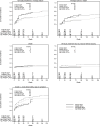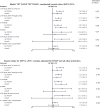Predictors of virologic and clinical response to nevirapine versus lopinavir/ritonavir-based antiretroviral therapy in young children with and without prior nevirapine exposure for the prevention of mother-to-child HIV transmission
- PMID: 25222305
- PMCID: PMC4166566
- DOI: 10.1097/INF.0000000000000337
Predictors of virologic and clinical response to nevirapine versus lopinavir/ritonavir-based antiretroviral therapy in young children with and without prior nevirapine exposure for the prevention of mother-to-child HIV transmission
Abstract
Background: In a randomized trial comparing nevirapine (NVP)-based versus lopinavir/ritonavir (LPV/r)-based antiretroviral therapy (ART) in HIV-infected children [primary endpoint discontinuation of study treatment for any reason or virologic failure by week 24] aged 2 months to 3 years, we assessed whether clinical, virologic, immunologic and safety outcomes varied by prior single-dose NVP exposure (PrNVP) for prevention of mother-to-child HIV transmission and other covariates.
Methods: Efficacy was assessed by time to ART discontinuation or virologic failure, virologic failure/death and death; safety by time to ART discontinuation because of a protocol-defined toxicity and first ≥ grade 3 adverse event; immunology and growth by changes in CD4%, weight/height World Health Organization z-scores from entry to week 48. Cox proportional hazards and linear regression models were used to test whether treatment differences depended on PrNVP exposure and other covariates.
Results: Over a median follow up of 48 (PrNVP) and 72 (no PrNVP) weeks, there was no evidence of differential treatment effects by PrNVP exposure or any other covariates. LPV/r-based ART was superior to NVP-based ART for efficacy and safety outcomes; however, those on NVP had larger improvements in CD4%, weight and height z-scores. Lower pretreatment CD4% and higher HIV-1 RNA levels were associated with reduced efficacy, lower pretreatment CD4% with shorter time to ART discontinuation because of a protocol-defined toxicity, and no PrNVP with shorter time to first grade ≥ 3 adverse event.
Conclusions: Differences between LPV/r and NVP ART in efficacy, safety, immunologic and growth outcomes did not depend on PrNVP exposure, prior breast-feeding, sex, HIV-1 subtype, age, pretreatment CD4%, HIV-1 RNA or World Health Organization disease stage. This finding should be considered when selecting an ART regimen for young children.
Trial registration: ClinicalTrials.gov NCT00307151.
Figures



References
-
- Jackson JB, Musoke P, Fleming T, et al. Intrapartum and neonatal single-dose nevirapine compared with zidovudine for prevention of mother to child transmission of HIV-1 in Kampala, Uganda: 18 month follow-up of the HIVNET 012 randomized trial. Lancet. 2003;362:859–68. - PubMed
-
- Lallemant M, Jourdain G, Le Coeur S, et al. A trial of shortened zidovudine regimens to prevent mother-to-child transmission of human immunodeficiency virus type 1. N Engl J Med. 2000;343:982–991. - PubMed
-
- Eshleman SH, Mracna M, Guay LA, et al. Selection and fading of resistance mutations in women and infants receiving nevirapine to prevent HIV-1 vertical transmission (HIVNET 012) AIDS. 2001;15:1951–1957. - PubMed
-
- McIntyre J, Hughes M, Mellors J, Zheng Y, Hakim J, Asmelash A, et al. Efficacy of ART with NVP+TDF/FTC vs LPV/r+TDF/FTC among Antiretroviral-naïve Women in Africa: OCTANE Trial 2/ACTG A5208; Conference on Retroviruses and Opportunistic Infections; San Francisco CA. 2010.
Publication types
MeSH terms
Substances
Associated data
Grants and funding
LinkOut - more resources
Full Text Sources
Other Literature Sources
Medical
Molecular Biology Databases
Research Materials

